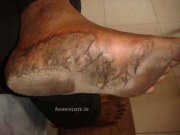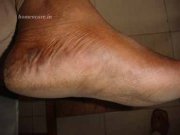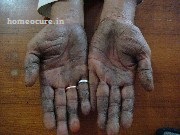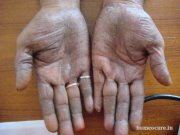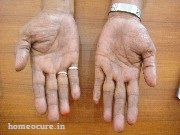-- Psoriasis --
Written by DrShailesh Doshi
It is a genetically determined skin infection characterised by development of chronic, well defined, scaly rash especially on elbows and knees, trunk, back and scalp. It very rarely affects the palms and soles. Nail involvement is very frequent and often gives the clue to the diagnosis. It is common in 16 to 22 years and 57 to 60 years age group. Female predominence is noted in the younger age group.
...... Causes ......

It is considered to be an autoimmune disease and has strong genetic predilection. Some precipitating and aggrevating causes are
- Physiological changes of puberty and pregnancy
- Intercurrent infections
- Endocrine imbalance
- Physical trauma
- Mental stress
- Some drugs like antimalarial,NSAIDs etc.
- Patients with HIV and AIDS
- Obesity and chronic alcoholism
Types and clinical features
...... Psoriasis vulgaris ......
These are scaly well defined rashes on extremeties, trunk ans scalp. Nail involvement is very common which often proceeds the skin infection. In initial stage there is small well circumscribed rash covered by dry loosely attached silvery white scales. On scrapping the white scales resembles wax candle, removal which reveals glistening red membrane. Small bleeding points are obvserved after breaking through the membrane which indicates active disease. Early lesions have typical salmon pink color while the chronic well established lesions acquire a dusky bluish hew specially on dark skin.
Active psoriasis is characterized by the appearance of new lesions at the site of trauma, infections and injury. Sunlight can precipitate new skin lesion on exposed areas. The initial site of involvement on elbows and knees. Others are scalp, trunk, back, palms, soles and nails.
Healing lesions of psoriasis become non-scaly and dusky in color and often leave behind post inflammatory hyper pigmented macules often with a ring of hypopigmentation. Scalp involvement is either localised or defused. Flexural invovement is termed inverse psoriasis. The lesions have shiny smooth surface and abscence of scaling. Scaly plaques studded with pustules or defused thickening of the skin are common presentation on palms and soul. Nail involvement is frequently associated with this variety of psoriasis.
The chronic type of psoriasis is very stable form and remain unchanged for many years except some seasonal variations ,with winter aggrevation.
...... Guttate psoriasis (Gutta = drop) ......
Commonly present in children and young patients chracterised by sudden crops of small, shiny papples on trunk and extremeties. The characteristic scales are abscent. In children upeer respiratoy tract infection is knwon to preeces the skin lesions by 2 to 3 weeks. This variety often subsides within a few weeks.
...... Exfoliative psoriasis ......
Abrupt discontinuation of steroids, administration of anti-malarials are some precipitating factors of such sudden wide spread involvement. Severe itching and burning are the disturbing symptoms. Complications like irregulation in intestinal absorption of proteins, water and electrolyte balance. Acute renal failure may occure due to diversion of large quantity of blood to the skin tissues.
...... Pustular psoriasis ......
In this variety tiny, superficial, sterile pustules appear either on the surface of psoriatic lesions or on previously unaffected skin. The localised variety mainly involves palm and soles while generalised type has widespread involvement with severe constitutional symptoms.
...... Psoriatic arthropathy ......
Pitting of nails is early and regular feature. The pits are deep seated and have uniform distribution on nails.

